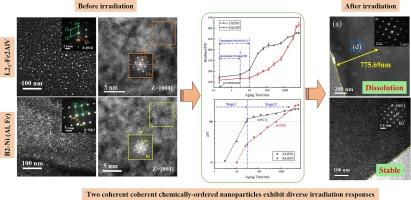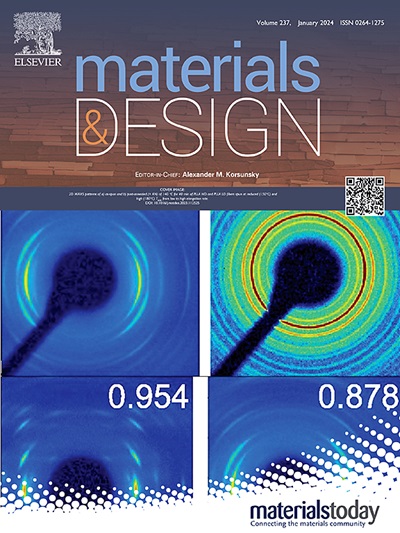离子辐照下相干纳米粒子卓越稳定性的来源
IF 7.6
2区 材料科学
Q1 MATERIALS SCIENCE, MULTIDISCIPLINARY
引用次数: 0
摘要
最近,人们发现了一种依赖于相干纳米粒子可逆无序阶跃转变的新型抗辐照机制,它能显著提高金属材料的微观结构稳定性和抗空洞膨胀性。然而,其出色的稳定性和超强的耐辐射性的决定因素仍不明确。在此,我们设计了两种铁铬铝合金,每种合金都由不同类型的相干相强化:L21 有序的 Fe2AlV 和 B2 有序的 Ni(Al,Fe)。据观察,这两种合金对高温下的高剂量离子辐照表现出不同的反应。发现 L21-Fe2AlV 沉淀物在 500-600 °C 的离子辐照 50 dpa 后完全溶解,而 B2-NiAl 沉淀物即使在 200 dpa 的辐照后仍保持稳定。这项研究挑战了传统观点,即纳米粒子的稳定性取决于辐射增强的粗化和辐射溶解之间的平衡。相反,它证明了再成核和随后由界面控制的溶质重新洗牌过程决定了高温辐照下相干化学有序纳米粒子的稳定性。我们证明,与简单化学有序晶格结构和低晶格错配界面有关的低界面能,是使这种短程元素重新洗牌过程反复形成纳米沉淀物的关键,而这种沉淀物是辐射无法抑制的。本文章由计算机程序翻译,如有差异,请以英文原文为准。

On the origin of superior stability of coherent nanoparticles under ion irradiation
Recently, a new anti-irradiation mechanism relying on reversible disorder-ordering transition of coherent nanoparticles was discovered, which significantly improves the microstructural stability and void swelling resistance of metallic materials. However, the factors that govern the outstanding stability and superb radiation tolerance are still not clear. Here, two kinds of FeCrAl alloys were designed, each strengthened by a different type of coherent phase: L21-ordered Fe2AlV and B2-ordered Ni (Al, Fe). It was observed that the two alloys exhibited disparate responses to high-dose ion irradiations at elevated temperatures. The L21-Fe2AlV precipitates were found to be completely dissolved after 50 dpa of ion irradiation at 500–600 °C, whereas the B2-NiAl precipitates remained stability even after 200 dpa irradiation. This research challenges the conventional wisdom that the stability of nanoparticles is governed by the balance between radiation-enhanced coarsening and radiation dissolution. Instead, it demonstrates the re-nucleation and subsequent interface-controlled solute reshuffling processes govern the stability of coherent chemically-ordered nanoparticles under radiation at high temperatures. We demonstrate that the low interfacial energy, which is related to both the simply chemically-ordered lattice structure and low lattice misfit interface, is crucial for enabling such short-range elemental reshuffling process to repeatedly form nanoprecipitates that cannot be suppressed by radiation.
求助全文
通过发布文献求助,成功后即可免费获取论文全文。
去求助
来源期刊

Materials & Design
Engineering-Mechanical Engineering
CiteScore
14.30
自引率
7.10%
发文量
1028
审稿时长
85 days
期刊介绍:
Materials and Design is a multi-disciplinary journal that publishes original research reports, review articles, and express communications. The journal focuses on studying the structure and properties of inorganic and organic materials, advancements in synthesis, processing, characterization, and testing, the design of materials and engineering systems, and their applications in technology. It aims to bring together various aspects of materials science, engineering, physics, and chemistry.
The journal explores themes ranging from materials to design and aims to reveal the connections between natural and artificial materials, as well as experiment and modeling. Manuscripts submitted to Materials and Design should contain elements of discovery and surprise, as they often contribute new insights into the architecture and function of matter.
 求助内容:
求助内容: 应助结果提醒方式:
应助结果提醒方式:


